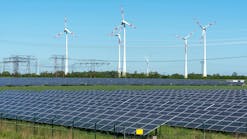National Grid has connected Enso Energy and Cero Generations Larks Green solar farm, the first photovoltaic (PV) solar array to connect directly to the UK’s electricity transmission network. The 50 MW solar plant, located on a 200-acre plot near Bristol, comprises 152,400 solar modules and has been connected to National Grid’s Iron Acton substation via a new high-voltage cable. The solar farm will generate over 73,000 MWh annually and will displace 20,500 tons of CO2 each year compared to traditional energy production. The site will also co-locate with a 49.5 MW / 99 MWh battery energy storage system (BESS), which will balance the intermittent energy production, maximize the site's efficiency and allow a greater output of clean energy.
Until now, all the UK’s solar farms have connected to the country’s distribution networks, making this a significant step toward the renewable energy transition. By connecting solar power directly to the transmission network, clean energy can now be transported over greater distances and larger projects can be connected to the grid. The announcement marks progress towards meeting Britain’s commitment to a fully decarbonized power system by 2035. The government’s recent Powering up Britain report reaffirmed its ambition for a five-fold increase in deployment of solar generation by 2035, with up to 70 GW installed - enough to power around 20 million homes.
The co-located solar farm and BESS project has been designed to produce a net biodiversity gain through the provision of resources for local wildlife, including additional woodland planting that will provide shelter and food for a range of protected species. Cero has 38 other standalone or co-located BESS projects in its UK pipeline within its partnership with Enso, with the existing pipeline extending to 5 GW and a further 5 GW of early-stage opportunities.
National Grid is investing in upgrading, adapting and maintaining its transmission network and has spent around £5 billion ($6.32 billion) on its infrastructure since 2018. The company plans to spend £9 billion ($11.38 billion) in the five years to 2026, with further multibillion-pound investments beyond that to 2030 to deliver an affordable, resilient, and clean energy system. National Grid is also working with ESO and the industry to introduce a series of measures to help speed up connections to the electricity transmission network, including a connections amnesty, new arrangements to manage the connections pipeline and a new two-stage offer process.


